- 1ASI—Italian Space Agency, Rome, Italy
- 2Space Research Institute, Austrian Academy of Sciences, Graz, Austria
- 3National Institute for Astrophysics, Institute for Space Astrophysics and Planetology, Rome, Italy
- 4Dipartimento di Fisica, Università Della Calabria, Rende, Italy
Slow solar wind, sharing magnetic and plasma properties typical of fast wind, the so-called slow Alfvénic wind, has been widely observed in the heliosphere. Here, we report an analysis of the turbulent properties of a slow Alfvénic stream observed by Solar Orbiter at 0.64 AU. This solar wind stream is characterized by well distinguishable regions, namely, a main portion, an intermediate region, and a rarefaction region. Each of those intervals have been studied separately, in order to enhance similarities and differences in their turbulence properties. Coherent structures naturally emerge over different time/spatial scales and their characteristics at ion scales have been investigated. The presence of these intermittent events have been found to be closely related to kinetic features in the ion (both proton and alpha particles) velocity distribution functions, suggesting a fundamental role in the kinetic physical processes that mediate the sub-ion turbulence cascade.
1 Introduction
Turbulence is ubiquitous in ordinary and magnetized fluids. It is characterized by a complex cross-scale coupling of the relevant fields, which induces their energy contained at large-scales to cascade all the way down to small scales. In particular, in collisionless plasmas, small scales are mediated by kinetic processes, where particles interact with electromagnetic fluctuations, giving rise to non-thermal features in the particle velocity distribution functions (VDFs), which appear as distortions and deviations from thermodynamic equilibrium (Marsch et al., 1982a; b). However, how turbulence interacts with particles remains one of the major unsolved problems in plasma physics, with strong implications for space (Bruno and Carbone, 2016; Verscharen et al., 2019), astrophysical (Webb et al., 2018; Verscharen et al., 2021), and laboratory plasmas (White et al., 2019). Since many of these plasmas can be described as turbulent collision-free systems, the heating process related to the irreversible degradation of information due to collisions, is missing (Pezzi et al., 2019; Matthaeus et al., 2020).
The heliosphere represents the best natural laboratory to study plasma turbulence, thanks to in-situ spacecraft measurements. This environment can be described as almost collisionless, magnetized, and quasi-neutral, and can represent a sample for plasma processes that occur also in distant astrophysical plasmas, such as the interstellar medium, plasma in astrophysical jets, or the intra-cluster medium. One example of heliospheric plasmas is the solar wind, a continuous, but highly variable, weakly collisional plasma flow originating at the Sun, which travels at high speed and interacts with the environment of the planets. The solar wind is in a state of fully developed turbulence and is dominated by a broad variety of processes, such as shocks, waves, coherent structures, magnetic reconnection, and particle acceleration (Marsch, 2006; Bruno and Carbone, 2013). This general picture of astrophysical turbulence becomes more complicated because of the multi-component nature of the solar wind. Although protons represent the main solar wind component, it is also made of a finite amount of doubled ionized helium (alpha particles), together with a few percentages of heavier ions, which are observed to be preferentially heated (Marsch et al., 1982a; Marsch et al., 1982b; Kasper et al., 2008).
Turbulent fluctuations of the fields in the solar wind are not homogeneous but are highly space-localized. The degree of non-homogeneity increases as the spatial/time scales decrease. This aspect of the solar wind turbulence is called intermittency and it is due to the emergence of coherent structures towards small scales, which can be described as strong discontinuities in the magnetic field (Retinò et al., 2007; Perri et al., 2012; Greco and Perri, 2014; Perrone et al., 2016; Perrone et al., 2017; Perrone et al., 2020; Perrone et al., 2022) over a broad range of scales (Greco et al., 2016; Lion et al., 2016). Both in-situ observations and numerical experiments have shown that coherent structures are strongly related to the presence of kinetic effects, such as particle energization, temperature anisotropy, and deviation from Maxwellian VDF (Matteini et al., 2010; Osman et al., 2010; Greco et al., 2012; Servidio et al., 2012; Servidio et al., 2015; Servidio et al., 2017; Perrone et al., 2013; Perrone et al., 2014; Wu et al., 2013; Pezzi et al., 2018; Sorriso-Valvo et al., 2018). Understanding the physical mechanisms that generate coherent structures and how these structures contribute to dissipation in collisionless plasma fits into the general problem of solar wind heating.
The bimodal structure of the solar-wind speed distribution (McGregor et al., 2011), characterized at 1 AU by two distinct peaks rather than a smooth transition, indicates that the solar wind can be described by two different types of plasma, namely, slow (∼400 km/s) and fast (∼800 km/s) solar wind, whose characteristics are strongly related to their source regions on the Sun. However, even if the standard classification between fast and slow solar wind is widely accepted, it cannot always explain the observations. Indeed, it is not rare to observe slow wind streams that, apart from the speed, have almost the same characteristics of the fast wind, mainly high degree of correlations between velocity and magnetic field components and low compressibility (i.e., Alfvénicity). This kind of wind, which is statistically relevant, is called slow Alfvénic wind (see D’Amicis et al., 2021b, for a review on this topic) and, recently, it has mostly been observed in the inner heliosphere by the new solar missions Parker Solar Probe (Fox et al., 2016) and Solar Orbiter (Müller et al., 2020).The first observation of a slow Alfvénic interval by Parker Solar Probe was during its first perihelion passage at about 0.17 AU from the Sun. This stream originated from a small equatorial coronal hole (Bale et al., 2019; Badman et al., 2020) and it was characterized by the presence of isolated intermittent velocity enhancements (Kasper et al., 2019; Horbury et al., 2020a) associated with magnetic field deflections, namely, switchbacks (Bale et al., 2019; Dudok de Wit et al., 2020). Then, Parker Solar Probe observed several intervals of slow Alfvénic wind during its initial encounters (see, e.g., Woolley et al., 2021). On the other hand, Solar Orbiter also measured in detail several intervals of slow Alfvénic wind in the inner heliosphere. In particular, the first observation occurred in July 2020 at a heliocentric distance of 0.64 AU (D’Amicis et al., 2021a), when Solar Orbiter was still in its cruise phase. The source region of this stream was identified in a coronal pseudostreamer configuration, whose topology allows the formation and development of twin filament channels (Panasenco et al., 2019), related to an anomalous expansion rate. The speed profile of this interval is very similar to the one typical of the fast wind, consisting in well-defined plasma regions, namely, a compression region (but in this case it is partially missing), a main portion of the stream and a rarefaction region. Moreover, here, another region between the main portion and the rarefaction region has been identified, which is characterized by a spaghetti-like flux-tube texture of the magnetic field with the presence of several large-scale structures (D’Amicis et al., 2021a).
In this paper, we study the nature of the turbulent magnetic fluctuations around proton scales in the interval of slow Alfvénic wind observed by Solar Orbiter in July 2020 (D’Amicis et al., 2021a). In particular, we focus on a 1 h interval of very high Alfvénicity in each well-defined plasma region identified and we statistically investigate the observed coherent structures. Finally, we study the link between coherent events and kinetic effects on the proton and alpha particles VDFs. The paper is organized as follows: in Section 2 Solar Orbiter observations of a slow Alfvénic stream are described along with a computation of the relevant plasma parameters; in Section 3 turbulence properties are studied in the three regions forming the data set; in Section 4 an analysis on the ion scale coherent magnetic structures is presented and the role played by such structures in the kinetic processes is also investigated and discussed; Section 5 shows our conclusions.
2 Alfvénic slow wind interval
In July 2020 Solar Orbiter was embedded in a slow Alfvénic solar wind stream at a radial distance of about 0.64 AU (D’Amicis et al., 2021a). In this paper, we consider three 1 h periods characterized by a very high value of the v-b correlation coefficient, namely,
between July 15th and July 18th, where Vj and Bj are the velocity and magnetic field single measurements and
2.1 Interval characterization
Figure 1 shows the plasma properties of the 1 h Alfvénic intervals in the main portion on July 15th (left column), intermediate region on July 16th (middle column), and rarefaction region on July 17th (right column) of the slow Alfvénic wind observed by Solar Orbiter (D’Amicis et al., 2021a). Each column, from top to bottom, displays: the three components in the radial tangential normal (RTN) reference frame (radial in blue, tangential in red, and normal in green) and magnitude (in black) of the magnetic field (panels a–c), and of the velocity field for the proton core, Vc (panels d–f); the cosine of the angle between B and Vc, cos θBV (panels g–i); the density for the proton core in green, nc, proton beam in orange, nb, and for alpha particles in violet, nα (panels j–l); and the temperature for the proton core in green, Tc, proton beam in orange, Tb, and for alpha particles in violet, Tα (panels m–o). For an easy comparison, in the latter plots, the alpha particle temperature has been divided by 4. Typical solar wind parameters, averaged within these intervals, can be found inTable 1.
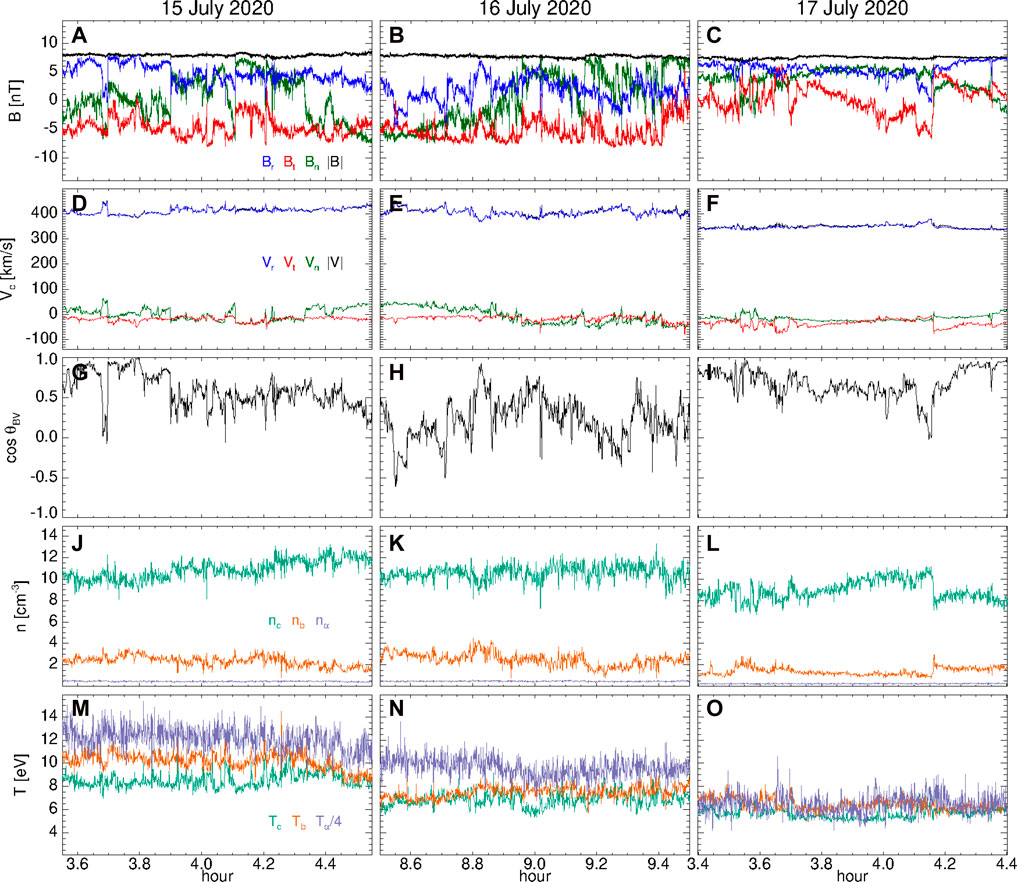
FIGURE 1. Characteristics of 1 h high-Alfvénic intervals in the main portion on July 15th (left column), intermediate region on July 16th (middle column), and rarefaction region on July 17th (right column) of the slow Alfvénic wind observed by Solar Orbiter in 2020. From top to bottom: components in RTN (radial in blue, tangential in red, and normal in green) and magnitude (in black) of the magnetic field vector (A–C); components in RTN and magnitude of the velocity field vector (for the proton core) with the same color legend used for the magnetic field in the first row (D–F); cosine of the angle between the velocity (of the proton core) and magnetic field vectors (G–I); density for the proton core (green) and beam (orange), and for alpha particles (violet) (J–L); and temperature for the proton core (green) and beam (orange), and for alpha particles (violet) (M–O). The alpha particle temperature has been divided by 4 to be easily compared with the proton temperature.
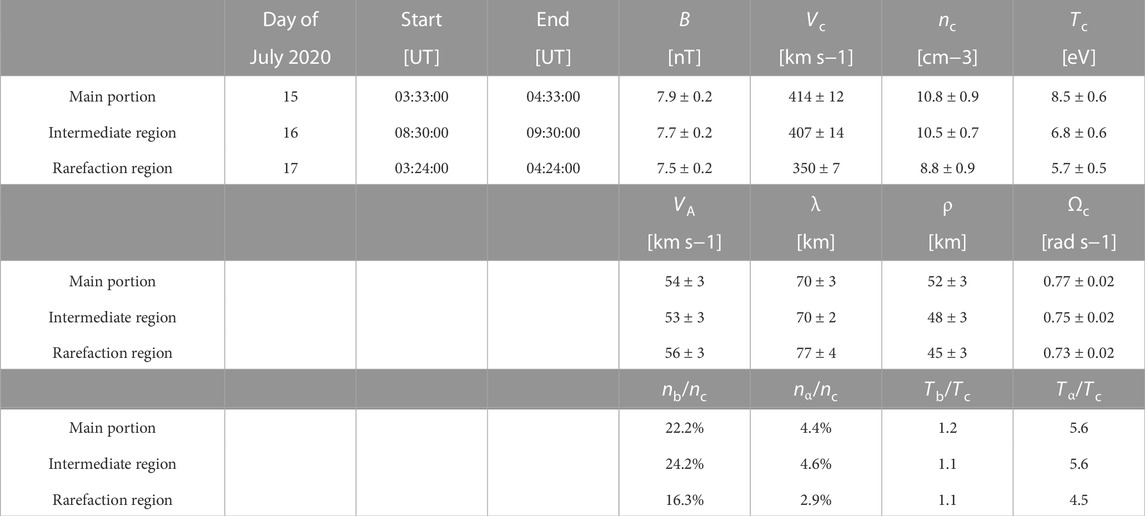
TABLE 1. Solar wind parameters averaged within each 1 h selected period in the slow Alfvénic interval observed by Solar Orbiter at 0.64 AU. We also report the Alfvén speed VA, the proton inertial length λ, the proton Larmor radius ρ, and the proton cyclotron frequency Ωc. Only the proton core has been considered for plasma parameters, but ratios between other populations, namely, proton beam and alpha particles, and proton core are given. The errors refer to the standard deviation evaluated in each period.
Each selected 1 h period shows a decrease of speed, as expected since from July 15th to July 17th Solar Orbiter moves from the main portion of the stream to the rarefaction region. However, all the intervals have an almost constant, and similar, magnetic field magnitude, even if the behavior of the magnetic components is quite different. Moreover, several deflections of the radial component Br (blue line), that is switchbacks, are recovered. These structures are associated with local enhancements in the proton speed and with changes in the cos θBV as in the case of the strong deflection at about 3.7 h on July 15th. It is worth pointing out that the presence of switchbacks does not influence the results on coherent structures, since we focus on scales much smaller than the switchback typical time scales. Then, panels (g)-(i) show a different behavior for the three periods and give a first indication on the different turbulence sampled by Solar Orbiter. Indeed, the spacecraft looks at a more parallel turbulence in the rarefaction region than in the intermediate one (see cos θBV).
The main differences between the three periods can be seen in the plasma quantities, such as density and temperature, by considering separately the different populations that constitute the solar wind plasma. Although the proton core density (and also the total ion density) is similar in both the main portion and the intermediate region, it does not follow the typical anti-correlation with the flow speed (see, e.g., Elliott et al., 2016). However, this anti-correlation is typically expected when the plasma parameters are averaged over larger time windows than the 4s resolution of the particle data used in the present analysis. In our work, we have considered all the timeseries variations within a 1h time window, thus producing a certain lack of stationarity that could influence the relation between the density and speed. On the other hand, higher proton core temperature is found for higher speed as expected (see, e.g., Perrone et al., 2019). Moreover, the percentage of the proton beam and alpha particles, with respect to the proton core, is very similar in the main portion and in the intermediate region but significantly decreases in the rarefaction region. Finally, the temperature ratio between the proton beam and the core is almost the same in the three periods, but not for the alpha particles. Indeed, Tα/Tc is about 5.6 in the main portion and in the intermediate region, but decreases (∼4.5) in the rarefaction region, meaning that in the first two regions alpha particles experience an anomalous heating while in the rarefaction region the two species have almost equal thermal speeds (Kasper et al., 2008).
3 Turbulence and intermittency
Solar wind measurements have revealed that the plasma is in a state of fully developed turbulence (Bruno and Carbone, 2013). The energy, stored in the electromagnetic and velocity fields, is injected at the Sun into the heliosphere and is channeled towards smaller time/spatial scales through a turbulent cascade until it is eventually dissipated. The magnetic power spectrum typically follows a Kolmogorov-like power law in the so-called inertial range, in analogy with ordinary fluids (Kolmogorov, 1941; Frisch, 1995; Tu and Marsch, 1995). At scales close to the characteristic ion lengths, namely, the ion Larmor radius or the ion skin depth, the spectrum becomes steeper (Alexandrova et al., 2013), the ions become unmagnetized, and the plasma dynamics is governed by kinetic features. Indeed, effects such as wave-particle interactions with strong anisotropies in the particle VDFs dominate the plasma dynamics and the fluid, intermediate scale treatment fails.
Panel (a) of Figure 2 shows the total power spectral density (PSD), namely, the trace of the spectral matrix, of the magnetic field for the 1 h periods in the main portion (green), in the intermediate region (orange), and in the rarefaction region (violet). The magnetic fluctuations show an almost similar power level in the three regions, even if the power is lower in the rarefaction region. To characterize the turbulence, the spectral indices γ and δ have been evaluated in the frequency range f ∈ [0.03, 0.15] Hz for the inertial range, and f ∈ [0.4, 1] Hz for the sub-proton range, respectively. Notice that the best fit performed in the high-frequency range is limited to a narrow range of frequencies because of the decrease of the signal-to-noise ratio. The spectral index values are summarized in Table 2. Although in the main portion and in the intermediate region we observe in the inertial range a power law close to the typical Kolmogorov scaling, the spectrum in the rarefaction region is steeper. Indeed, the angle θBV indicates that in this period Solar Orbiter is sampling the solar wind mainly parallel to the local magnetic field, suggesting a slope closer to −2 in the inertial range, as predicted by the critical balance theory (Goldreich and Sridhar, 1995; Horbury et al., 2008). However, the observed deviation from −2 (i.e., γ ≃ − 1.89 ± 0.04, in the rarefaction region) can be explained by different reasons, such as a quasi parallel sampling by the spacecraft (Horbury et al., 2008), the applicability of the critical balance theory to strong turbulence, or the presence of intermittency. Another difference between the rarefaction region and the other two periods is related to the position of the spectral break (indicated by stars in Figure 2A), which has been evaluated by fitting a power law decay on either side of the break and finding the intersection of both curves (Perri et al., 2010; Bruno and Trenchi, 2014). Indeed, in the main portion and in the intermediate region the spectral break frequency is around 0.3 Hz, while in the rarefaction region is around 0.2 Hz. These frequencies are closer to the proton cyclotron resonance frequencies (dashed lines), namely, fR = Vc*fc/(VA + Vth,c) ≃ 0.5 Hz (Bruno and Trenchi, 2014), being fc the proton gyrofrequency, than the other proton characteristic frequencies, namely, the timescales corresponding to the proton Larmor radius (dot-dot-dot-dashed lines) and to the proton inertia length (dot-dashed lines), which are located at about 1 Hz.
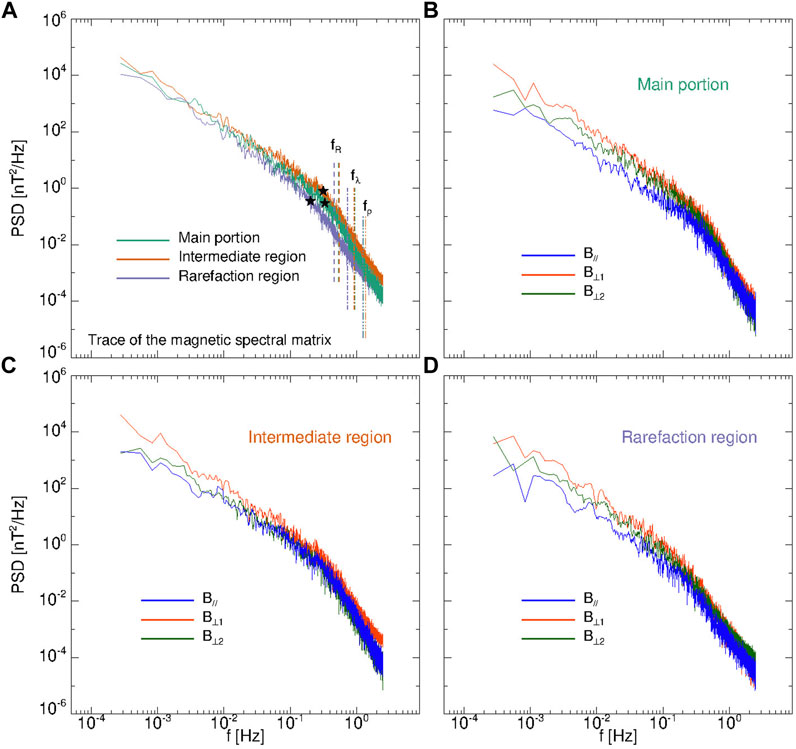
FIGURE 2. Power spectral density (PSD) of the total magnetic field fluctuations (A) for the 1 h intervals in the main portion (green), intermediate region (orange) and rarefaction region (violet). The stars refer to the spectral breaks, while vertical lines refer to the proton characteristic frequencies, namely, the cyclotron resonance frequency, fR (dashed lines), the frequencies corresponding to the Larmor radius, fρ (dot-dot-dot-dashed lines), and to the inertial length, fλ (dot-dashed lines). PSDs of the components of the magnetic field in the mean magnetic field reference frame (parallel direction in blue) for the main portion (B) intermediate region (C) and rarefaction region (D).
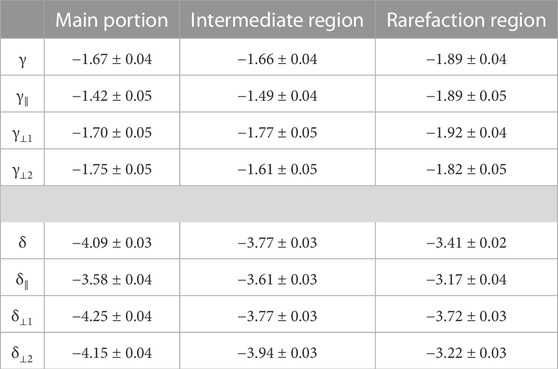
TABLE 2. Spectral indices γ and δ evaluated in the frequency range f ∈[0.03,0.15] Hz for the inertial range and f ∈[0.4,1] Hz for the sub-proton range, respectively, for the turbulent spectra in Figure 2.
To better appreciate the anisotropy of the magnetic field, in panels (b)-(d) we show for each selected interval the PSD of the magnetic field components in the mean field reference frame. Thus, the magnetic field data have been rotated in a reference frame in which the x-axis is aligned with the mean field direction (the average value of B computed over each entire interval), the y-axis is along the V ×B direction, and the z-axis completes the frame. As expected for Alfvénic intervals, in the inertial range the power stored in the fluctuations parallel to the mean field tends to be lower than the power stored in the transverse components (Bruno and Carbone, 2013).
We have also analyzed the degree of intermittency of our samples by computing the kurtosis (Frisch, 1995), namely, the fourth-order moment of the distribution of the magnetic field increments δB (t, τ) = B (t + τ) − B(t) at each time scale τ:
where
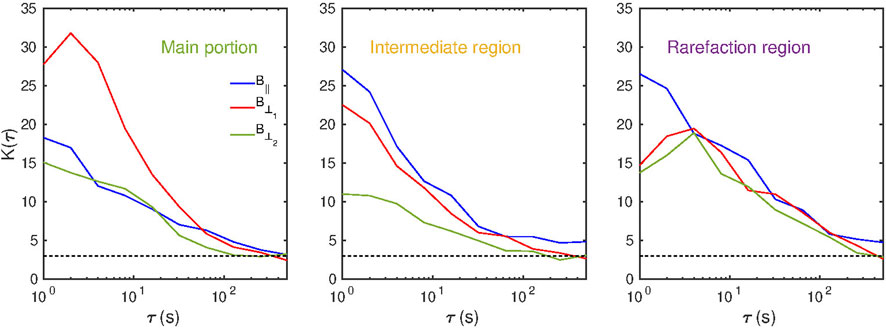
FIGURE 3. Fourth-order moments of the magnetic field fluctuations (kurtosis) as a function of the time scale for the component of B parallel to the mean field direction (blue line) and for the two perpendicular components (red and green lines). The reference value of 3 expected for a Gaussian distribution of magnetic field increments is also shown (dashed line). Each panel refers to the different intervals here analyzed.
4 Coherent events and kinetic effects
Beyond the general information about the global properties of the turbulent activity provided by the magnetic field spectra, here we focus on the details of the turbulence properties and, in particular, we study the distribution in time and frequency of the magnetic field energy by using a local analysis of the fluctuations. Panels (a-c) and (d-f) of Figure 4 show the behaviour of the Local Intermittency Measure (LIM; Farge, 1992) for the parallel and perpendicular magnetic energy, respectively. The LIM is defined as the energy of magnetic fluctuations, as a function of time (t) and timescales (τ), normalized at each time point by a mean spectrum over the whole time interval, namely,
where the brackets indicate a time average while
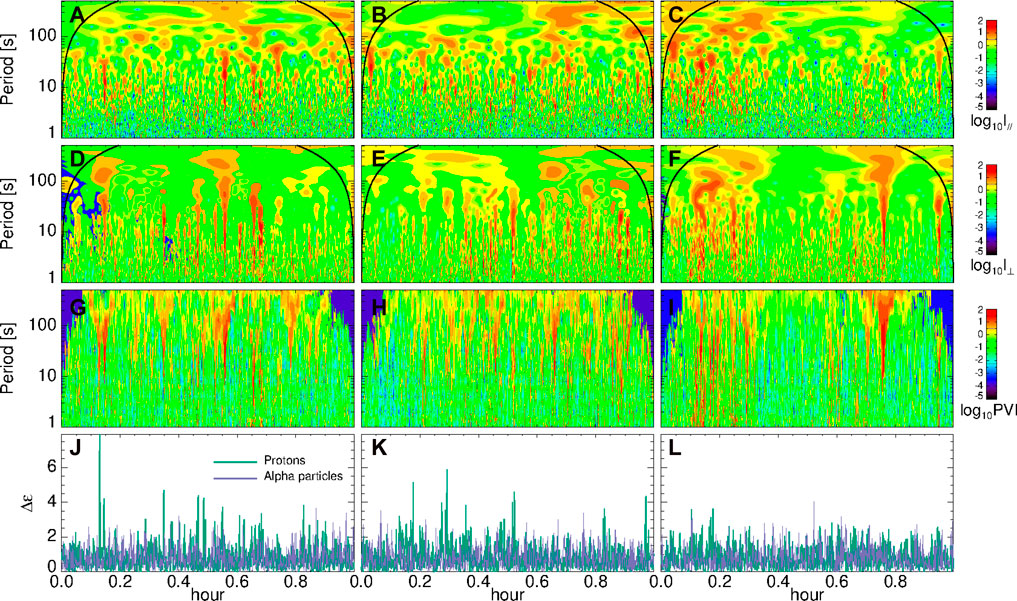
FIGURE 4. Logarithmic contour plots of the local intermittency measure (LIM) of the parallel, I∥ (A–C), and perpendicular, I⊥ (D–F), magnetic field fluctuations, where curved lines, at each side of the plots, indicate the cone of influence. Logarithmic contour plots of the magnetic PVI (G–I). Dimensionless proton (green) and alpha particle (violet) increment of non-Maxwellianity parameter, Δϵ (J–L).
Most of the studies of plasma discontinuities are based on the use of the partial variance of increments (PVI) technique (Greco et al., 2008) or Haar wavelet (Veltri and Mangeney, 1999). These methods are oriented to catch planar/slab discontinuities in different regimes of the turbulence cascade. Indeed, they have been found to be efficient in detecting one-dimensional current sheets (Veltri, 1999; Bruno et al., 2001; Osman et al., 2010; Greco et al., 2012; Osman et al., 2012; Perri et al., 2012; Greco and Perri, 2014; Greco et al., 2016). The advantage of using PVI with respect to wavelets is related to its straightforward computation, since it just depends on the magnetic field increments, δB(t, τ), that is the difference between the magnetic field values at two different times separated by a time lag τ, as (Greco et al., 2008)
being ⟨⋯ ⟩ a time average over the entire dataset. Panels (g-i) of Figure 4 show the scalograms for the magnetic PVI, which look very similar to the panels (a)-(f). Thus, localized (in time) channels of large amplitude PVI and LIM broaden over time scales, implying that within these channels magnetic energy is cascading from large time scales towards small time scales.
In order to enhance how such non-homogeneous (in time) channels influence kinetic physics, we have computed the deviation of the proton and alpha VDF from the thermodynamic equilibrium by means of the parameter ϵs, called non-Maxwellianity, defined as (Greco et al., 2012; Valentini et al., 2016)
where ns is the density for a species s, fs is the measured VDF and gs is the associated Maxwellian distribution with the same density, temperature and velocity as the observed one. Panels (j-l) show the dimensionless proton (green) and alpha particle (violet) increments of non-Maxwellianity, Δϵ. Indeed, following the PVI technique, we have computed normalised increments for ϵs on a time scale of 8 s, which is very close to the spectral break. We observe a clear correspondence, especially in the main portion and intermediate region, between the presence of strong intermittent events and the distortion of both proton and alpha particle VDFs.
4.1 Identification and statistical analysis of coherent events
We focus on the nature of the turbulent magnetic field fluctuations around the spectral break, adopting a bandpass filter based on the wavelet transform (Torrence and Compo, 1998; He et al., 2012; Perrone et al., 2016; Perrone et al., 2017; Perrone et al., 2020; Perrone et al., 2022). We have selected a frequency ranges around proton scales, namely, f ∈ [0.1, 1] Hz to study kinetic effects. Magnetic fluctuations are then defined as
where
The presence of large amplitude (in magnetic energy) events, already highlighted by LIM and PVI in Figure 4, has been confirmed by significant non-Gaussian tails in the PDFs of δbi (not shown here). We decided to study them by selecting only the fluctuations that exceed three standard deviations from the corresponding Gaussian distribution (which includes 99.7% of the Gaussian contribution). More than a hundred intermittent events have been detected by an automated method (see Perrone et al., 2016, for details) for each selected 1 h period. Then, we perform a minimum variance analysis (Sonnerup and Scheible, 1998) around each selected peak in magnetic energy, corresponding to magnetic fluctuations well-localized in time and with a regular profile in a range, Δt′, namely, the width of the event, defined as the time interval between two minima of energy that contains the selected maximum over the threshold. Moreover, we define the characteristic temporal scale of the event, Δt (<Δt′), as the width at half-height of the maximum (Perrone et al., 2016).
Figure 5 shows the results of the statistical analysis on the intermittent events observed in the 1 h intervals in the main portion (green), intermediate region (orange) and rarefaction region (violet). Panel (a) displays the PDFs of the orientation of the eigenvectors, θ, with respect to the local magnetic field, b0, which has been averaged within each structure, namely, in Δt′. In all the periods, θmax is perpendicular to b0, confirming the absence of compressive events due to the high Alfvénicity of the intervals. Indeed, the most peaked distribution around 90° is the one corresponding to the main portion (green line), which is also characterized by the highest Alfvénicity (see Figure 1). On the other hand, the distributions of θmin are more uniform, with a slight peak at very small angles. A different behavior is observed for the angle between the magnetic and velocity field vectors, θBV, within the structures. Indeed, in panel (b), we find three distinct peaks, where 30° < θBV < 60° in the rarefaction region (violet line), 50° < θBV < 65° in the main portion (green line), and θBV ∼ 80° in the intermediate region (orange line). This behavior, which reflects the same behavior observed for the whole three 1 h periods (see panels g–i of Figure 1), suggests that the misalignment of b0 and v0 is supported by the presence of large-scale structures, as the spaghetti-like flux-tube texture of the magnetic field observed by D’Amicis et al. (2021b), which produces strong discontinuities. Three distinct peaks are also recovered for the proton plasma beta (panel c). Here, we evaluated a reduced parameter, since in βp we consider only the proton core population. However, the same physics (the peaks are only shifted to higher values) is found if we take into account the moments of the ion (proton + alpha particles) distribution. As in the case of θBV, the distribution of the local βp, i.e., within Δt′, reflects the global behavior observed for the same parameter in the whole intervals. Finally, to better characterize the compressibility of the structures, we evaluated the local magnetic compressibility, ζ∥, defined as in Perrone et al. (2016).
where parallel and perpendicular directions are estimated with respect to b0 and the maximum of the magnetic components is evaluated within Δt′. Panel (d) in Figure 5 shows a slight shift towards higher values of ζ∥, even if very small, going from the main portion to the rarefaction region. Indeed, this behavior is expected since the three select intervals are strongly Alfvénic but the amplitude of the Alfvénic fluctuations decreases going towards the rarefaction region.
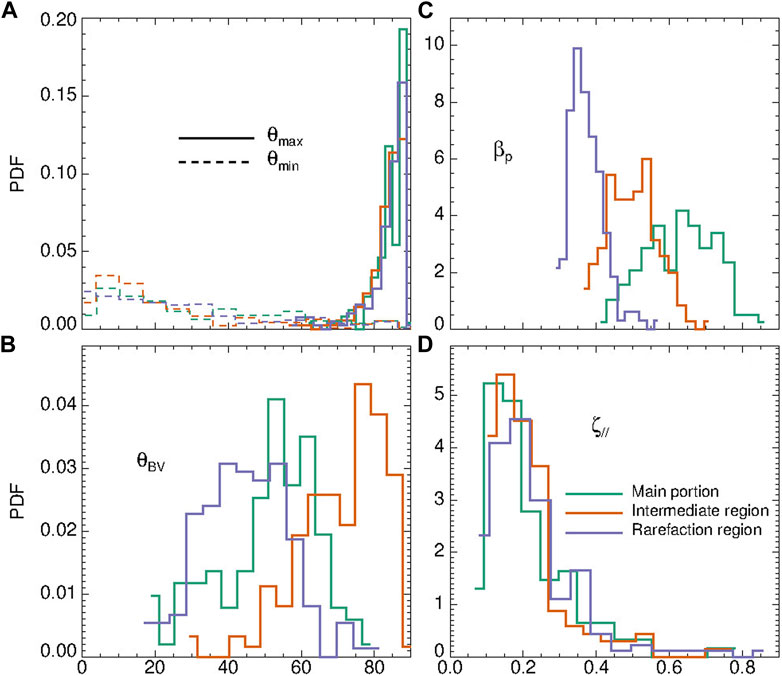
FIGURE 5. Statistical analysis of the observed coherent events for the 1 h intervals in the main portion (green), intermediate region (orange) and rarefaction region (violet). Left panels: PDFs of the angles between the maximum (solid line) and the minimum (dashed line) variance directions and the local magnetic field (A); and θBV (B). Right panels: PDFs of the reduced proton plasma beta, βp (C), evaluated by considering only the proton core, and the local magnetic compressibility, ζ∥ (D).
4.2 Example of coherent structures: Vortex chain
Looking into the details of each intermittent structure observed in all the selected periods, we can conclude that these events can be described mostly as currents sheets and vortex-like structures. In particular, vortices can be observed as very isolated structures or grouped in chains. The latter are very interesting. Indeed, numerical simulations have shown that turbulence leads to the generation of current sheets and vortices, which evolve in time interacting nonlinearly among each others (see, e.g., Servidio et al., 2012; Perrone et al., 2013;Servidio et al., 2015). Assuming to use a virtual spacecraft in the simulations, which samples magnetic field data along a linear trajectory in the numerical box, it would cross discontinuities and magnetic islands, with the latter appearing as a vortex chain.
An example of a vortex chain crossed by Solar Orbiter is shown in Figure 6. Panel (a) displays the three components of the bandpassed magnetic field fluctuations, defined in Eq. 6, in the local magnetic field reference frame. The yellow box marks the width of the central vortex, Δt′, where the analyses (such as the minimum variance analysis and the local mean parameter estimations) have been performed. Indeed, the minimum variance analysis has highlighted that magnetic fluctuations are characterized by λmin ≪ λint < λmax and the main variance is in the plane perpendicular to b0, with very small compressive fluctuations, δbz ≪ δbx, δby. Moreover, we find that θmax ∼ 87° and θmin ∼ 75°, while θint ∼ 15°. Finally, its characteristic width is Δr ∼ 1400 km ∼ 18λi or ∼ 27ρi, assuming that the structure is convected by the wind. The nature of the structure is confirmed by the other panels of Figure 6, which display hodographs of the magnetic field vector (normalized to max (|δb|)) in the plane perpendicular to b0 (panel b) and in the planes containing δbz and δbx (c) or δby (d). Indeed, a rotation in the plane perpendicular to the local magnetic field is observed in the central vortex. Moreover, panel (b) suggests that similar structures are present on both sides of the central vortex that the automatic method selects. These two other vortices are also well localized and they are characterized by very small compressive fluctuations (see also panel a).
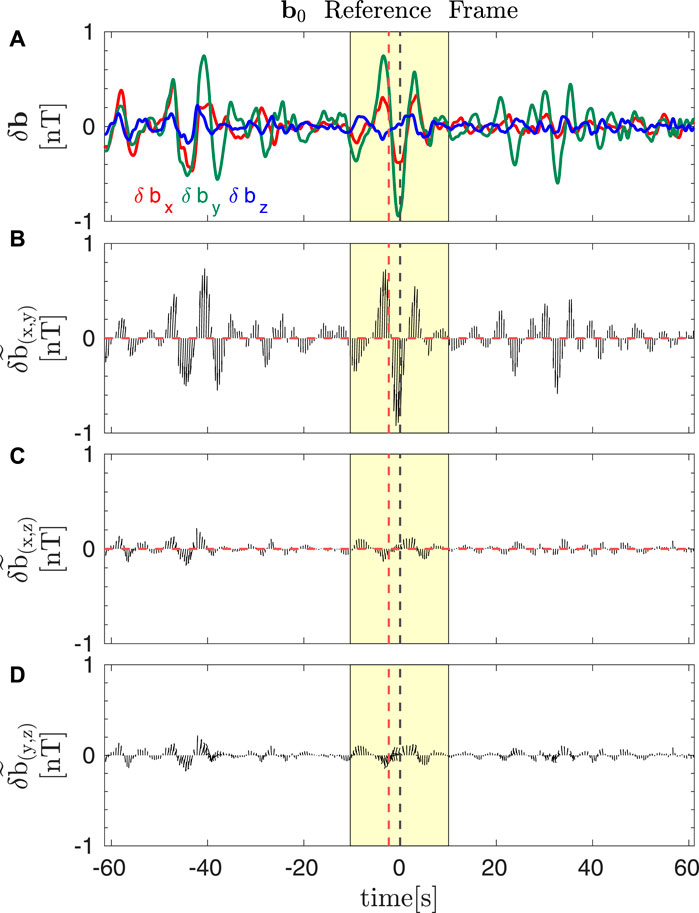
FIGURE 6. Example of a vortex chain centered at 03:27:56.58 UT (black vertical dashed line) on July 17th. From top to bottom: components of the magnetic field fluctuations, defined in Eq. 6, in the local magnetic field reference frame, where b0 is along the z-direction (A); hodographs of the magnetic field vector (normalized to max (|δb|)) in the plane perpendicular to b0 (B) and in the planes that contains δbz and δbx (C) or δby (D). The yellow shadow highlights the extension of the central vortex, Δt′. Finally, the red vertical dashed line marks the time at which the proton and the alpha VDF were taken and showed in Figure 7.
Coherent structures are generally connected to strong distortions in the ion VDFs, such as the presence of a secondary field-aligned beam. Since coherent structures are usually characterized by strong and rapid rotations of the magnetic field direction, the position of the beam could move during the time to collect measurements, thus producing artificial temperature anisotropy. However, stable beams have been observed in both numerical experiments (see, e.g., Valentini et al., 2008; Valentini and Veltri, 2009; Valentini et al., 2010; Valentini et al., 2011) and in-situ observations (see, e.g., Sorriso-Valvo et al., 2019). Here, a first indication of the distortion in the 3D ion VDFs is provided by the increased non-Maxwellianity parameter in correspondence of such intermittent regions and strong discontinuities (see Figure 4). However, in order to investigate this point in more detail, we have directly checked the ion velocity distributions. In particular, in Figure 7, we show an example of 2D contour plots of both proton and alpha particle VDFs at the time 03:27:55.78 UT, close to the center of the main vortex structure (red vertical dashed line in Figure 6), and integrated along the out-plane direction. The VDF of each ion population (protons and alpha particles) is displayed in their respective rest frame. We also point out the different scales of the colorbars for each of the two species which remark the fact that alpha particles are only ∼ 4% of the proton core (see Table 1). From left to right, both proton and alpha particle VDFs are shown in the planes (v∥, v⊥,1), (v∥, v⊥,2) and (v⊥,1, v⊥,2), respectively, where v∥ represents the direction of the local magnetic field evaluated as an average over 1 s around the time of the considered VDF (which corresponds approximately to the time of acquisition of the 3D VDF by PAS); v⊥,2 is the direction perpendicular to both the local magnetic field and the local proton bulk velocity, and v⊥,2 is the cross product v⊥,2 × v∥. In the planes containing the magnetic field direction, the proton VDF shows a clear and stable field-aligned beam, panels (a) and (b), while it is gyrotropic in the plane perpendicular to the magnetic field (panel c). Indeed, even after the crossing of the structure, the proton beam is present and stable, showing a timescale longer than the time to collect counts. This suggests that the beam and the related temperature anisotropy are physical features. Moreover, we interestingly find that the alpha particle VDF shows an oblique beam, directed mostly in the negative ⊥, 1 direction (panel d), while it is mostly isotropic in panel (e) and gyrotropic in panel (f). We also point out that the same kinetic features are observed in correspondence of the other two vortex structures detected right before and after the main one. The presence of such a beam in the alpha particle VDFs needs further investigation.
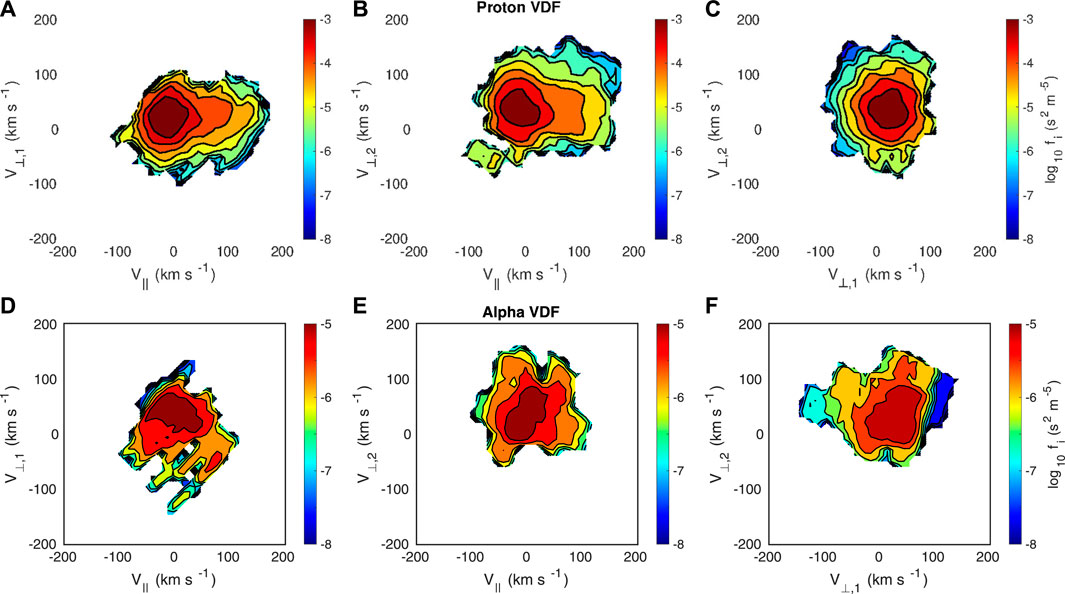
FIGURE 7. 2D contour plots of the reduced velocity distribution functions of protons (A–C) and alpha particles (D–F) plotted in the rest frame coordinate system and at the time 03:27:55.78 UT on July 17th (see red vertical dashed line in Figure 6). From left to right, the distribution functions are showed in the planes determined by the local magnetic field and the bulk velocity: (v∥, v⊥,1), (v∥, v⊥,2) and (v⊥,1, v⊥,2), respectively.
5 Discussion
We have investigated the turbulence properties around a range of time scales (frequencies) where kinetic effects start dominating the plasma dynamics in the slow Alfvénic solar wind interval detected by Solar Orbiter at 0.64 AU. In particular, we have focused on a 1 h interval of very high Alfvénicity (that is the correlation between large amplitude velocity and magnetic field components) in each of the three distinguishable regions, namely, a main portion, an intermediate region and a rarefaction region (D’Amicis et al., 2021b), where the plasma parameters tend to show slight different behaviours. Going from the large scale characteristics of this sample of solar wind, an overview of the characteristics of the magnetic fluctuations from the inertial to sub-proton time scales, ending with the analysis of the ion distribution functions, is given. The main results can be summarized as follows:
• the alignment between the magnetic and the velocity field vectors changes passing from the main portion to the intermediate region and then to the rarefaction region, having an effect on the slope of the magnetic field power spectral densities. Indeed, during the rarefaction region crossing, the radial direction is more aligned to the magnetic field and consequently the slope of the PSD in the inertial range is closer to the predicted limit γ∥ = −2 (Goldreich and Sridhar, 1995);
• all the three regions are characterized by coherent magnetic structures over a broad range of time scales and highly localized in time. The two techniques used to detect coherent structures, i.e., PVI and LIM, give very similar results. These structures are characterized by a local increase of magnetic energy both along the direction parallel to the mean magnetic field and perpendicular to it. They are responsible for a high level of intermittency through all the three regions;
• interestingly enough, coherent structures tend to be correlated with the presence of gradients in the non-Maxwellianity parameter ϵs (both for protons and alpha particles). This parameter, ϵs, quantifies the degree of deviation of the VDF of a given species from its associated Maxwellian distribution. It has largely been used both in simulations and in spacecraft observations (Greco et al., 2012; Valentini et al., 2016; Perri et al., 2020);
• most of the detected structures in the three regions (more than 96% of all events, which becomes 99% for the structures in the main region) are almost perpendicular to the local mean field (namely, θmax > 70°), so that they have a very low level of compressibility. The identified coherent structures are mainly current sheets, isolated vortices or vortex chains. One example of vortex chain is also reported in detail, with a description of the associated distorted VDFs both for protons and alpha particles. Indeed, while for the protons the presence of a typical field aligned beam can be easily recognized (Marsch et al., 1982b; Marsch, 2006), in the alpha particle VDFs an oblique beam with respect to the local direction of the magnetic field is detected. This feature appears also related to the other vortices of this chain and requires a further analysis. The structures here detected share similar characteristics to the ones observed in other types of wind (Greco et al., 2016; Perrone et al., 2016; Perrone et al., 2017; Perrone et al., 2020; Perrone et al., 2022), thus giving indication of common turbulent energy channels through the scales. Thanks to all these observations, we finally start to have a good statistics on structures properties, enabling us to unveil the processes responsible for magnetic energy dissipation and solar wind heating.
Data availability statement
Publicly available datasets were analyzed in this study. This data can be found here: https://soar.esac.esa.int/soar/.
Author contributions
DP and SP conceived the data analysis. DP wrote the article. SP helped to write the article. AS performed the analysis on the velocity distribution functions with the support of RM, who provided the revised plasma data. RA, AS, and RM contributed to the text writing and helped in improving the analysis and interpreting the data. All authors contributed to the article and approved the submitted version.
Funding
SP is supported by the Italian Space Agency and the National Institute of Astrophysics, in the framework of the CAESAR (Comprehensive spAce wEather Studies for the ASPIS prototype Realization) project, through the ASI-INAF n. 2020-35-HH.0 agreement for the development of the ASPIS (ASI SPace weather InfraStructure) prototype of scientific data centre for Space Weather.
Acknowledgments
Solar Orbiter is a space mission of international collaboration between ESA and NASA, operated by ESA. Solar Orbiter Solar Wind Analyser (SWA) data are derived from scientific sensors which have been designed and created, and are operated under funding provided in numerous contracts from the UK Space Agency (UKSA), the UK Science and Technology Facilities Council (STFC), the Agenzia Spaziale Italiana (ASI), the Centre National d’Etudes SpaDales (CNES, France), the Centre National de la Recherche Scientifique (CNRS, France), the Czech contribution to the ESA PRODEX programme and NASA. DP, SP, and AS would like to acknowledge the International Space Science Institute (ISSI) for its support of the team “Unravelling solar wind microphysics in the inner heliosphere” dedicated in part to the analysis of Solar Orbiter data.
Conflict of interest
The authors declare that the research was conducted in the absence of any commercial or financial relationships that could be construed as a potential conflict of interest.
Publisher’s note
All claims expressed in this article are solely those of the authors and do not necessarily represent those of their affiliated organizations, or those of the publisher, the editors and the reviewers. Any product that may be evaluated in this article, or claim that may be made by its manufacturer, is not guaranteed or endorsed by the publisher.
References
Alexandrova, O., Chen, C. H. K., Sorriso-Valvo, L., Horbury, T. S., and Bale, S. D. (2013). Solar wind turbulence and the role of ion instabilities. Space Sci. Rev. 178, 101–139. doi:10.1007/s11214-013-0004-8
Badman, S. T., Bale, S. D., Oliveros, J. C. M., Panasenco, O., Velli, M., Stansby, D., et al. (2020). Magnetic connectivity of the ecliptic plane within 0.5 au: potential field source surface modeling of the first parker solar probe encounter. Astrophysical J. Suppl. Ser. 246, 23. doi:10.3847/1538-4365/ab4da7
Bale, S. D., Badman, S. T., Bonnell, J. W., Bowen, T. A., Burgess, D., Case, A. W., et al. (2019). Highly structured slow solar wind emerging from an equatorial coronal hole. Nature 576, 237–242. doi:10.1038/s41586-019-1818-7
Bruno, R., and Carbone, V. (2013). The solar wind as a turbulence laboratory. Living Rev. Sol. Phys. 10, 2. doi:10.12942/lrsp-2013-2
Bruno, R., and Carbone, V. (2016). “Turbulence in the solar wind,” in Lecture notes in physics (Berlin, Germany: Springer). doi:10.1007/978-3-319-43440-7
Bruno, R., Carbone, V., Veltri, P., Pietropaolo, E., and Bavassano, B. (2001). Identifying intermittency events in the solar wind. Planet. Space Sci. 49, 1201–1210. doi:10.1016/S0032-0633(01)00061-7
Bruno, R., and Trenchi, L. (2014). Radial dependence of the frequency break between fluid and kinetic scales in the solar wind fluctuations. Astrophysical J. Lett. 787, L24. doi:10.1088/2041-8205/787/2/L24
D’Amicis, R., Bruno, R., Panasenco, O., Telloni, D., Perrone, D., Marcucci, M. F., et al. (2021a). First Solar Orbiter observation of the Alfvénic slow wind and identification of its solar source. Astronomy Astrophysics 656, A21. doi:10.1051/0004-6361/202140938
D’Amicis, R., Perrone, D., Bruno, R., and Velli, M. (2021b). On alfvénic slow wind: A journey from the earth back to the sun. J. Geophys. Res. (Space Phys. 126, e28996. doi:10.1029/2020JA028996
De Marco, R., Bruno, R., Jagarlamudi, V. K., D’Amicis, R., Marcucci, M. F., Fortunato, V., et al. (2023). Innovative technique for separating proton core, proton beam, and alpha particles in solar wind 3D velocity distribution functions. Astronomy Astrophysics 669, A108. doi:10.1051/0004-6361/202243719
Dudok de Wit, T., Krasnoselskikh, V. V., Bale, S. D., Bonnell, J. W., Bowen, T. A., Chen, C. H. K., et al. (2020). Switchbacks in the near-sun magnetic field: long memory and impact on the turbulence cascade. Astrophysical J. Suppl. Ser. 246, 39. doi:10.3847/1538-4365/ab5853
Elliott, H. A., McComas, D. J., and DeForest, C. E. (2016). Long-term trends in the solar wind proton measurements. Astrophysical J. 832, 66. doi:10.3847/0004-637X/832/1/66
Farge, M. (1992). Wavelet transforms and their applications to turbulence. Annu. Rev. Fluid Mech. 24, 395–458. doi:10.1146/annurev.fl.24.010192.002143
Fox, N. J., Velli, M. C., Bale, S. D., Decker, R., Driesman, A., Howard, R. A., et al. (2016). The solar probe plus mission: humanity’s first visit to our star. Space Sci. Rev. 204, 7–48. doi:10.1007/s11214-015-0211-6
Goldreich, P., and Sridhar, S. (1995). Toward a theory of interstellar turbulence. 2: strong alfvenic turbulence. Astrophysical J. 438, 763. doi:10.1086/175121
Greco, A., Chuychai, P., Matthaeus, W. H., Servidio, S., and Dmitruk, P. (2008). Intermittent MHD structures and classical discontinuities. Geophys. Res. Lett. 35, L19111. doi:10.1029/2008GL035454
Greco, A., and Perri, S. (2014). Identification of high shears and compressive discontinuities in the inner heliosphere. Astrophysical J. 784, 163. doi:10.1088/0004-637X/784/2/163
Greco, A., Perri, S., Servidio, S., Yordanova, E., and Veltri, P. (2016). The complex structure of magnetic field discontinuities in the turbulent solar wind. Astrophysical J. Lett. 823, L39. doi:10.3847/2041-8205/823/2/L39
Greco, A., Valentini, F., Servidio, S., and Matthaeus, W. H. (2012). Inhomogeneous kinetic effects related to intermittent magnetic discontinuities. Phys. Rev. E 86, 066405. doi:10.1103/PhysRevE.86.066405
He, J., Tu, C., Marsch, E., and Yao, S. (2012). Do oblique alfvén/ion-cyclotron or fast-mode/whistler waves dominate the dissipation of solar wind turbulence near the proton inertial length? Astrophysical J. Lett. 745, L8. doi:10.1088/2041-8205/745/1/L8
Horbury, T. S., Forman, M., and Oughton, S. (2008). Anisotropic scaling of magnetohydrodynamic turbulence. Phys. Rev. Lett. 101, 175005. doi:10.1103/PhysRevLett.101.175005
Horbury, T. S., O’Brien, H., Carrasco Blazquez, I., Bendyk, M., Brown, P., Hudson, R., et al. (2020a). The solar orbiter magnetometer. Astronomy Astrophysics 642, A9. A9, doi:10.1051/0004-6361/201937257
Horbury, T. S., Woolley, T., Laker, R., Matteini, L., Eastwood, J., Bale, S. D., et al. (2020b). Sharp alfvénic impulses in the near-sun solar wind. Astrophysical J. Suppl. Ser. 246, 45. doi:10.3847/1538-4365/ab5b15
Kasper, J. C., Bale, S. D., Belcher, J. W., Berthomier, M., Case, A. W., Chandran, B. D. G., et al. (2019). Alfvénic velocity spikes and rotational flows in the near-sun solar wind. Nature 576, 228–231. doi:10.1038/s41586-019-1813-z
Kasper, J. C., Lazarus, A. J., and Gary, S. P. (2008). Hot solar-wind helium: direct evidence for local heating by alfvén-cyclotron dissipation. Phys. Rev. Lett. 101, 261103. doi:10.1103/PhysRevLett.101.261103
Kolmogorov, A. (1941). The local structure of turbulence in incompressible viscous fluid for very large Reynolds’ numbers. Akad. Nauk. SSSR Dokl. 30, 301–305. doi:10.1098/rspa.1991.0075
Lion, S., Alexandrova, O., and Zaslavsky, A. (2016). Coherent events and spectral shape at ion kinetic scales in the fast solar wind turbulence. Astrophysical J. 824, 47. doi:10.3847/0004-637X/824/1/47
Marsch, E. (2006). Kinetic physics of the solar corona and solar wind. Living Rev. Sol. Phys. 3, 1. doi:10.12942/lrsp-2006-1
Marsch, E., Rosenbauer, H., Schwenn, R., Muehlhaeuser, K. H., and Neubauer, F. M. (1982a). Solar wind helium ions: observations of the Helios solar probes between 0.3 and 1 AU. J. Geophys. Res. 87, 35–51. doi:10.1029/JA087iA01p00035
Marsch, E., Schwenn, R., Rosenbauer, H., Muehlhaeuser, K. H., Pilipp, W., and Neubauer, F. M. (1982b). Solar wind protons: three-dimensional velocity distributions and derived plasma parameters measured between 0.3 and 1 AU. J. Geophys. Res. 87, 52–72. doi:10.1029/JA087iA01p00052
Marsch, E., and Tu, C. Y. (1997). Intermittency, non-Gaussian statistics and fractal scaling of MHD fluctuations in the solar wind. Nonlinear Process. Geophys. 4, 101–124. doi:10.5194/npg-4-101-1997
Matteini, L., Landi, S., Velli, M., and Hellinger, P. (2010). Kinetics of parametric instabilities of alfvén waves: evolution of ion distribution functions. J. Geophys. Res. Space Phys. 115. doi:10.1029/2009JA014987
Matthaeus, W. H., Yang, Y., Wan, M., Parashar, T. N., Bandyopadhyay, R., Chasapis, A., et al. (2020). Pathways to dissipation in weakly collisional plasmas. Astrophysical J. 891, 101. doi:10.3847/1538-4357/ab6d6a
McGregor, S. L., Hughes, W. J., Arge, C. N., Odstrcil, D., and Schwadron, N. A. (2011). The radial evolution of solar wind speeds. J. Geophys. Res. (Space Phys. 116, A03106. doi:10.1029/2010JA016006
Müller, D., St Cyr, O. C., Zouganelis, I., Gilbert, H. R., Marsden, R., Nieves-Chinchilla, T., et al. (2020). The Solar Orbiter mission. Science overview. Astronomy Astrophysics 642, A1. doi:10.1051/0004-6361/202038467
Osman, K. T., Matthaeus, W. H., Greco, A., and Servidio, S. (2010). Evidence for inhomogeneous heating in the solar wind. Astrophysical J. Lett. 727, L11. doi:10.1088/2041-8205/727/1/L11
Osman, K. T., Matthaeus, W. H., Hnat, B., and Chapman, S. C. (2012). Kinetic signatures and intermittent turbulence in the solar wind plasma. Phys. Rev. Lett. 108, 261103. doi:10.1103/PhysRevLett.108.261103
Owen, C. J., Bruno, R., Livi, S., Louarn, P., Al Janabi, K., Allegrini, F., et al. (2020). The solar orbiter solar wind analyser (SWA) suite. Astronomy Astrophysics 642, A16. doi:10.1051/0004-6361/201937259
Panasenco, O., Velli, M., and Panasenco, A. (2019). Large-scale magnetic funnels in the solar corona. Astrophysical J. 873, 25. doi:10.3847/1538-4357/ab017c
Perri, S., Carbone, V., Vecchio, A., Bruno, R., Korth, H., Zurbuchen, T. H., et al. (2012). Phase-synchronization, energy cascade, and intermittency in solar-wind turbulence. Phys. Rev. Lett. 109, 245004. doi:10.1103/PhysRevLett.109.245004
Perri, S., Carbone, V., and Veltri, P. (2010). Where does fluid-like turbulence break down in the solar wind? Astrophysical J. Lett. 725, L52–L55. doi:10.1088/2041-8205/725/1/l52
Perri, S., Perrone, D., Yordanova, E., Sorriso-Valvo, L., Paterson, W. R., Gershman, D. J., et al. (2020). On the deviation from Maxwellian of the ion velocity distribution functions in the turbulent magnetosheath. J. Plasma Phys. 86, 905860108. doi:10.1017/S0022377820000021
Perrone, D., Alexandrova, O., Mangeney, A., Maksimovic, M., Lacombe, C., Rakoto, V., et al. (2016). Compressive coherent structures at ion scales in the slow solar wind. Astrophysical J. 826, 196. doi:10.3847/0004-637X/826/2/196
Perrone, D., Alexandrova, O., Roberts, O. W., Lion, S., Lacombe, C., Walsh, A., et al. (2017). Coherent structures at ion scales in fast solar wind: cluster observations. Astrophysical J. 849, 49. doi:10.3847/1538-4357/aa9022
Perrone, D., Bruno, R., D’Amicis, R., Telloni, D., De Marco, R., Stangalini, M., et al. (2020). Coherent events at ion scales in the inner heliosphere: parker solar probe observations during the first encounter. Astrophysical J. 905, 142. doi:10.3847/1538-4357/abc480
Perrone, D., Perri, S., Bruno, R., Stansby, D., D’Amicis, R., Jagarlamudi, V. K., et al. (2022). Evolution of coronal hole solar wind in the inner heliosphere: combined observations by Solar Orbiter and Parker Solar Probe. Astronomy Astrophysics 668, A189. doi:10.1051/0004-6361/202243989
Perrone, D., Stansby, D., Horbury, T. S., and Matteini, L. (2019). Thermodynamics of pure fast solar wind: radial evolution of the temperature-speed relationship in the inner heliosphere. Mon. Notices R. Astronomical Soc. 488, 2380–2386. doi:10.1093/mnras/stz1877
Perrone, D., Valentini, F., Servidio, S., Dalena, S., and Veltri, P. (2014). Analysis of intermittent heating in a multi-component turbulent plasma. Eur. Phys. J. D 68, 209. doi:10.1140/epjd/e2014-50152-1
Perrone, D., Valentini, F., Servidio, S., Dalena, S., and Veltri, P. (2013). Vlasov simulations of multi-ion plasma turbulence in the solar wind. Astrophysical J. 762, 99. doi:10.1088/0004-637X/762/2/99
Pezzi, O., Perrone, D., Servidio, S., Valentini, F., Sorriso-Valvo, L., and Veltri, P. (2019). Proton–proton collisions in the turbulent solar wind: hybrid Boltzmann–maxwell simulations. Astrophysical J. 887, 208. doi:10.3847/1538-4357/ab5285
Pezzi, O., Servidio, S., Perrone, D., Valentini, F., Sorriso-Valvo, L., Greco, A., et al. (2018). Velocity-space cascade in magnetized plasmas: numerical simulations. Phys. Plasmas 25, 060704. doi:10.1063/1.5027685
Retinò, A., Sundkvist, D., Vaivads, A., Mozer, F., André, M., and Owen, C. J. (2007). In situ evidence of magnetic reconnection in turbulent plasma. Nat. Phys. 3, 235–238. doi:10.1038/nphys574
Servidio, S., Chasapis, A., Matthaeus, W. H., Perrone, D., Valentini, F., Parashar, T. N., et al. (2017). Magnetospheric multiscale observation of plasma velocity-space cascade: hermite representation and theory. Phys. Rev. Lett. 119, 205101. doi:10.1103/PhysRevLett.119.205101
Servidio, S., Valentini, F., Califano, F., and Veltri, P. (2012). Local kinetic effects in two-dimensional plasma turbulence. Phys. Rev. Lett. 108, 045001. doi:10.1103/PhysRevLett.108.045001
Servidio, S., Valentini, F., Perrone, D., Greco, A., Califano, F., Matthaeus, W. H., et al. (2015). A kinetic model of plasma turbulence. J. Plasma Phys. 81, 325810107. doi:10.1017/S0022377814000841
Sonnerup, B. U. Ö., and Scheible, M. (1998). Minimum and maximum variance analysis. ISSI Sci. Rep. Ser. 1, 185–220.
Sorriso-Valvo, L., Carbone, V., Veltri, P., Consolini, G., and Bruno, R. (1999). Intermittency in the solar wind turbulence through probability distribution functions of fluctuations. Geophys. Res. Lett. 26, 1801–1804. doi:10.1029/1999GL900270
Sorriso-Valvo, L., Catapano, F., Retinò, A., Le Contel, O., Perrone, D., Roberts, O. W., et al. (2019). Turbulence-driven ion beams in the magnetospheric kelvin-helmholtz instability. Phys. Rev. Lett. 122, 035102. doi:10.1103/PhysRevLett.122.035102
Sorriso-Valvo, L., Perrone, D., Pezzi, O., Valentini, F., Servidio, S., Zouganelis, I., et al. (2018). Local energy transfer rate and kinetic processes: the fate of turbulent energy in two-dimensional hybrid vlasov–maxwell numerical simulations. J. Plasma Phys. 84, 725840201. doi:10.1017/S0022377818000302
Torrence, C., and Compo, G. P. (1998). A practical guide to wavelet analysis. Bull. Am. Meteorological Soc. 79, 61–78. doi:10.1175/1520-0477(1998)079¡0061:APGTWA¿2.0.CO;2
Tu, C. Y., and Marsch, E. (1995). MHD structures, waves and turbulence in the solar wind: observations and theories. Space Sci. Rev. 73, 1–210. doi:10.1007/BF00748891
Valentini, F., and Veltri, P. (2009). Electrostatic short-scale termination of solar-wind turbulence. Phys. Rev. Lett. 102, 225001. doi:10.1103/PhysRevLett.102.225001
Valentini, F., Califano, F., Perrone, D., Pegoraro, F., and Veltri, P. (2011). New ion-wave path in the energy cascade. Phys. Rev. Lett. 106, 165002. doi:10.1103/PhysRevLett.106.165002
Valentini, F., Califano, F., and Veltri, P. (2010). Two-dimensional kinetic turbulence in the solar wind. Phys. Rev. Lett. 104, 205002. doi:10.1103/PhysRevLett.104.205002
Valentini, F., Perrone, D., Stabile, S., Pezzi, O., Servidio, S., De Marco, R., et al. (2016). Differential kinetic dynamics and heating of ions in the turbulent solar wind. New J. Phys. 18, 125001. doi:10.1088/1367-2630/18/12/125001
Valentini, F., Veltri, P., Califano, F., and Mangeney, A. (2008). Cross-scale effects in solar-wind turbulence. Phys. Rev. Lett. 101, 025006. doi:10.1103/PhysRevLett.101.025006
Veltri, P., and Mangeney, A. (1999). “Scaling laws and intermittent structures in solar wind MHD turbulence,” in Solar wind nine. Editors S. R. Habbal, R. Esser, J. V. Hollweg, and P. A. Isenberg (Nantucket: American Institute of Physics), 543–546. doi:10.1063/1.58809
Veltri, P. (1999). MHD turbulence in the solar wind: self-similarity, intermittency and coherent structures. Plasma Phys. Control. Fusion 41, A787–A795. doi:10.1088/0741-3335/41/3A/071
Verscharen, D., Klein, K. G., and Maruca, B. A. (2019). The multi-scale nature of the solar wind. Living Rev. Sol. Phys. 16, 5. doi:10.1007/s41116-019-0021-0
Verscharen, D., Wicks, R. T., Alexandrova, O., Bruno, R., Burgess, D., Chen, C. H. K., et al. (2021). A case for electron-astrophysics. Exp. Astron. 54, 473–519. doi:10.1007/s10686-021-09761-5
Webb, G. M., Barghouty, A. F., Hu, Q., and le Roux, J. A. (2018). Particle acceleration due to cosmic-ray viscosity and fluid shear in astrophysical jets. Astrophysical J. 855, 31. doi:10.3847/1538-4357/aaae6c
White, T. G., Oliver, M. T., Mabey, P., Kühn-Kauffeldt, M., Bott, A. F. A., Döhl, L. N. K., et al. (2019). Supersonic plasma turbulence in the laboratory. Nat. Commun. 10, 1758. doi:10.1038/s41467-019-09498-y
Woolley, T., Matteini, L., McManus, M. D., Berčič, L., Badman, S. T., Woodham, L. D., et al. (2021). Plasma properties, switchback patches, and low α-particle abundance in slow Alfvénic coronal hole wind at 0.13 au. Mon. Notices R. Astronomical Soc. 508, 236–244. doi:10.1093/mnras/stab2281
Keywords: plasma turbulence, solar wind, intermittency, coherent structures, velocity distribution functions, kinetic effects, solar orbiter
Citation: Perrone D, Settino A, De Marco R, D’Amicis R and Perri S (2023) Ion kinetic effects linked to magnetic field discontinuities in the slow Alfvénic wind observed by Solar Orbiter in the inner heliosphere. Front. Astron. Space Sci. 10:1250219. doi: 10.3389/fspas.2023.1250219
Received: 29 June 2023; Accepted: 19 September 2023;
Published: 06 November 2023.
Edited by:
Lingling Zhao, University of Alabama in Huntsville, United StatesReviewed by:
Joseph E. Borovsky, Space Science Institute (SSI), United StatesLaxman Adhikari, University of Alabama in Huntsville, United States
Copyright © 2023 Perrone, Settino, De Marco, D’Amicis and Perri. This is an open-access article distributed under the terms of the Creative Commons Attribution License (CC BY). The use, distribution or reproduction in other forums is permitted, provided the original author(s) and the copyright owner(s) are credited and that the original publication in this journal is cited, in accordance with accepted academic practice. No use, distribution or reproduction is permitted which does not comply with these terms.
*Correspondence: Denise Perrone, ZGVuaXNlLnBlcnJvbmVAYXNpLml0
 Denise Perrone
Denise Perrone Adriana Settino2
Adriana Settino2 Raffaella D’Amicis
Raffaella D’Amicis Silvia Perri
Silvia Perri